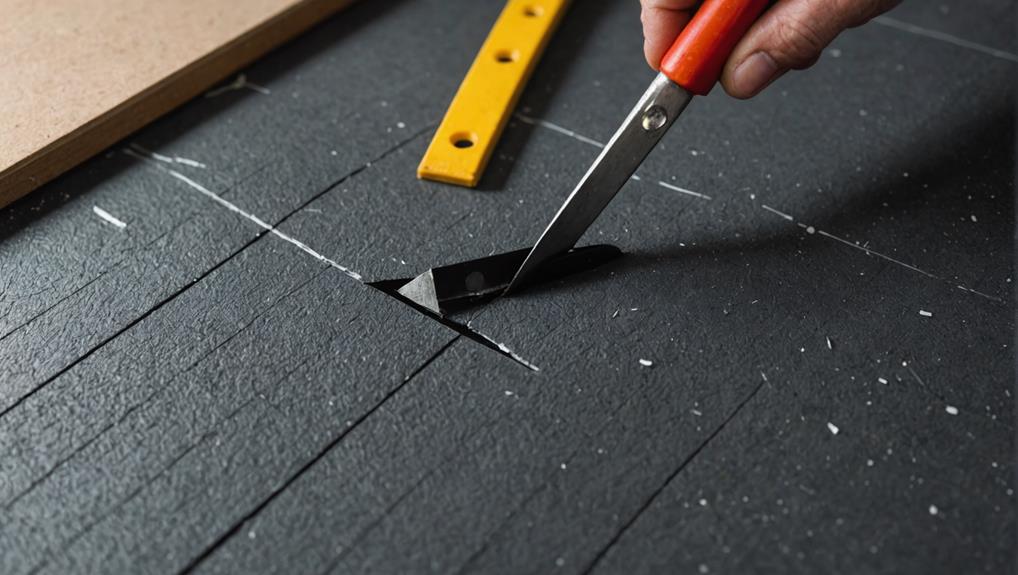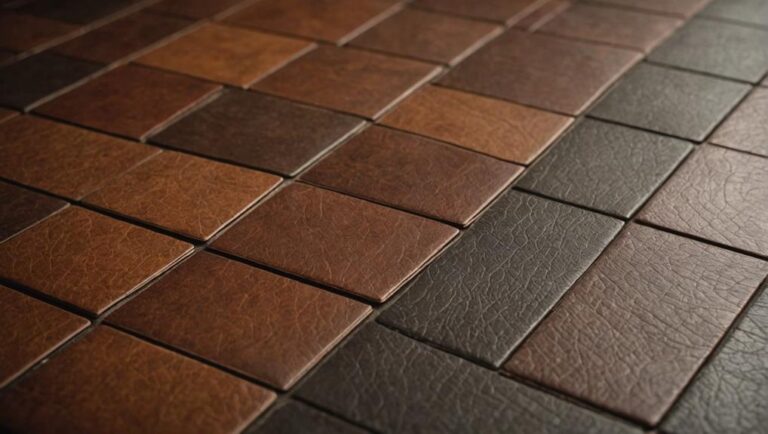To fix tears and punctures in rubber flooring, you should start by evaluating the damage through a thorough visual inspection. Gather a reliable repair kit and select a high-quality adhesive meant for rubber. Clean the area gently with a suitable solution, making sure it's free of debris and moisture. For small tears, evenly apply adhesive and press the edges tightly together. For punctures, cut a patch that adequately covers the hole, adhere it with the chosen adhesive, and let it cure as instructed. Understanding the repair techniques and maintenance strategies will guarantee long-lasting results.
Common Causes of Damage
Rubber flooring can frequently suffer from tears due to a variety of common causes. One of the primary reasons is inadequate impact resistance, especially in high-traffic areas. When heavy objects are dropped or dragged across the surface, the flooring can experience localized stress that leads to tearing. Regular monitoring of wear patterns can help identify areas that may require additional protection or reinforcement.
Another common cause of damage is the use of improper cleaning agents or tools. Harsh chemicals or abrasive scrubbers can degrade the rubber material over time, making it more susceptible to tears. It is crucial to follow manufacturer recommendations for cleaning solutions to maintain the integrity of the flooring.
Environmental factors can also contribute to rubber flooring damage. For instance, exposure to extreme temperatures can cause the material to harden or become brittle, increasing the likelihood of cracks and tears. Additionally, moisture accumulation can weaken the adhesive bond, leading to lifting and potential tearing.
Assessing the Damage
When evaluating the damage to your rubber flooring, it is vital to conduct a thorough inspection to identify the extent and nature of the tears. A detailed damage assessment will help you determine the best approach for repair. Start with a meticulous visual inspection of the flooring surface, looking for any signs of damage that may have been overlooked.
During your inspection, consider the following aspects:
- Size of the Tear: Measure the dimensions of the damage to understand its severity.
- Location: Identify whether the tear is in a high-traffic area or a less frequented space, as this can influence repair strategies.
- Type of Damage: Distinguish between surface cuts, deep punctures, or large tears, as each may require different repair methods.
- Underlying Issues: Check for any underlying moisture or structural problems that may have contributed to the damage.
As you assess the flooring, it's important to take notes and document your findings. A methodical approach not only aids in planning repairs but also guarantees safety. If the damage is extensive, you may want to consult a professional to confirm that the flooring can be restored effectively. Remember, the key to a successful repair lies in accurately understanding the damage before proceeding with any corrective actions.
Gathering Necessary Tools
Before you begin the repair process, you'll need to gather the necessary tools and materials to guarantee a successful fix. First and foremost, it's vital to have a reliable rubber flooring repair kit. These kits typically include patches, adhesive, and a spreader, which will be significant for applying the flooring adhesives effectively. Confirm that the kit you choose is compatible with your specific type of rubber flooring.
Next, consider a high-quality flooring adhesive. Select an adhesive formulated specifically for rubber materials to guarantee a strong bond and long-lasting repair. Check the manufacturer's guidelines for any recommendations regarding adhesives to avoid compatibility issues.
In addition to the repair kit and adhesive, you'll need a few basic tools. A utility knife will be important for trimming any damaged sections of the flooring before you apply the patch. Having a measuring tape on hand allows you to verify the patch fits correctly. You might also want to use a roller or a heavy object to apply even pressure during the drying process, confirming the adhesive cures properly.
Safety gear is also important. Wear gloves to protect your hands from chemicals in the adhesives and any sharp tools. Safety goggles can protect your eyes from debris while you're working. With these tools and materials ready, you'll be well-equipped to tackle the repair process effectively and safely.
Cleaning the Affected Area
Cleaning the affected area is essential for guaranteeing a successful repair of your rubber flooring. Proper surface preparation not only enhances the adhesion of your repair materials but also helps in preventing future damage. Before you begin, gather your cleaning solutions and tools to effectively tackle the task.
First, you'll want to select appropriate cleaning solutions. Avoid harsh chemicals that could damage the rubber. Instead, consider using:
- Mild dish soap mixed with warm water
- Vinegar and water solution
- Specialized rubber floor cleaners
- Rubbing alcohol for stubborn stains
Once you've chosen your cleaning solution, follow these steps for effective cleaning:
- Clear the area: Remove furniture or any items obstructing the damaged spot.
- Apply the cleaning solution: Use a soft cloth or sponge to gently scrub the area, making sure you don't cause further damage.
- Rinse thoroughly: After cleaning, rinse the area with clean water to eliminate any residue from the cleaning solution.
- Dry completely: Use a dry cloth to absorb excess moisture, as any remaining dampness can affect the repair process.
Taking the time to clean and prepare the surface properly is vital. This guarantees that the adhesives or sealants you use will bond effectively, leading to a more durable and long-lasting repair. Remember, a clean surface is the first step towards restoring the integrity of your rubber flooring.
Repairing Small Tears
When you notice small tears in your rubber flooring, the first step is evaluating the damage to determine the best course of action. After that, it's crucial to clean the area thoroughly to guarantee proper adhesion for the repair. Finally, you can apply a suitable repair product to restore the flooring's integrity.
Assessing the Damage
Evaluating the damage to small tears in rubber flooring is crucial for determining the appropriate repair method. A thorough damage assessment helps you identify the extent of the tear and the best materials for repair. Begin with a careful surface evaluation, taking note of the following factors:
- Size of the tear
- Location on the flooring
- Condition of the surrounding material
- Potential for further damage
Once you've noted these aspects, it's easier to decide if a simple adhesive will suffice or if more extensive repairs are needed. Small tears often require less invasive methods, but improper assessment can lead to bigger issues down the line.
Make certain to examine the area under good lighting and consider any underlying moisture or debris that could affect the integrity of the repair. Always prioritize safety by using protective gear during your assessment, and make sure the area is free from foot traffic to prevent accidents. By conducting a meticulous evaluation, you'll set the stage for a successful repair and help maintain the longevity of your rubber flooring.
Cleaning the Area
Before you start repairing small tears in rubber flooring, it's vital to verify the area is thoroughly cleaned. Proper surface preparation is essential to guarantee that the repair material adheres correctly and effectively. Begin by removing any loose debris or dirt around the tear. A soft broom or vacuum can assist in this initial cleanup.
Next, select an appropriate cleaning solution. Mild soap mixed with warm water is often effective, but confirm it's compatible with your rubber flooring. Apply the cleaning solution with a soft cloth or sponge, focusing on the tear and surrounding area. Gently scrub to eliminate any grime or oils that could hinder adhesion.
After cleaning, rinse the area with clean water to remove any soap residue, as this can also affect the repair process. Use a dry cloth to absorb excess moisture, guaranteeing the surface is completely dry before proceeding to the next steps. This thorough cleaning and surface preparation will not only enhance the effectiveness of your repair but also contribute to the longevity of your rubber flooring. Remember, safety first: always wear gloves when handling cleaning solutions and confirm adequate ventilation.
Applying the Repair
Applying the repair material accurately is essential for fixing small tears in rubber flooring. To achieve a seamless repair, you need to select the right adhesive type and apply it with precision. Begin by gathering your repair materials, guaranteeing you have everything needed to complete the task effectively.
Follow these steps for a successful repair:
- Choose the right adhesive type: Use a rubber flooring adhesive that's compatible with your flooring material.
- Prepare the tear: Make sure the edges of the tear are clean and free from debris.
- Apply the adhesive: Use a small applicator or a putty knife to spread the adhesive evenly over the tear, ensuring full coverage.
- Press and hold: After applying the adhesive, press the torn edges together firmly and hold for the recommended time to guarantee a strong bond.
Ascertain you allow the adhesive to cure completely before walking on the repaired area. This adherence to safety will not only provide a lasting fix but also maintain the integrity of your flooring. By following these steps, you can effectively repair small tears and restore your rubber flooring's functionality.
Fixing Punctures Effectively
When dealing with punctures in rubber flooring, the first step is to accurately identify the extent of the damage. Different repair techniques can be applied based on the size and location of the puncture. Understanding these methods will guarantee you choose the most effective solution for restoring your flooring.
Identify the Damage
Identifying punctures in rubber flooring is vital for effective repairs. Not only does this help maintain the integrity of your flooring, but it also guarantees safety in the area. Here's how to recognize the damage:
- Look for small holes or indentations, which are clear signs of punctures.
- Check for any raised edges around the puncture, indicating the rubber has been compromised.
- Examine the surrounding area for types of tears, as they may provide context for the damage.
- Assess whether the puncture is deep enough to affect the underlying substrate, which could lead to further issues.
You'll want to act quickly upon spotting these problems. Ignoring punctures can lead to larger tears, causing not only aesthetic damage but also safety hazards. A well-maintained rubber flooring surface reduces the risk of slips and falls, making it essential to identify and address any punctures immediately. With careful observation, you can guarantee that your rubber flooring remains functional and safe for use. Remember, the sooner you identify punctures, the easier it'll be to implement effective repairs.
Repair Techniques Overview
Once you've pinpointed the punctures in your rubber flooring, it's time to explore the various repair techniques available to restore its integrity. The first step involves selecting the appropriate adhesive types. Generally, you'll find two main categories: solvent-based and water-based adhesives. Solvent-based adhesives offer stronger bonds but may require more ventilation during application. Water-based adhesives are safer and easier to clean, making them ideal for residential settings.
Next, consider utilizing repair kits specifically designed for rubber flooring. These kits typically include an adhesive, patch material, and application tools. When using a repair kit, you should start by cleaning the area surrounding the puncture, ensuring that it's free from dirt and moisture. Cut the patch material to a size that adequately covers the puncture, then apply the adhesive according to the manufacturer's instructions.
After placing the patch, press it firmly into place and allow it to cure as recommended. This process not only fills the puncture but also helps restore the flooring's structural integrity. Always prioritize safety by using gloves and ensuring proper ventilation while working with adhesives. Following these techniques will help you maintain your rubber flooring effectively.
Preventative Maintenance Tips
To maintain the integrity of your rubber flooring, regular preventative maintenance is crucial. By implementing a proactive maintenance schedule, you can greatly reduce the risk of tears and punctures, guaranteeing a safer environment for everyone. Here are some key preventative measures to take into account:
- Regular Cleaning: Clean your rubber flooring frequently using a pH-neutral cleaner. This helps remove dirt and debris that can cause wear over time.
- Immediate Spill Management: Address spills immediately to prevent slipping hazards and potential damage to the floor's surface.
- Proper Equipment Use: Confirm that any equipment or furniture used on the flooring has appropriate pads or wheels to minimize abrasion.
- Routine Inspections: Conduct regular inspections for signs of wear or damage. Early detection allows for timely repairs before issues escalate.
Frequently Asked Questions
Can I Use Duct Tape for Temporary Repairs?
Oh sure, duct tape's the magical fix for everything, isn't it? While it's a popular choice for temporary solutions, its effectiveness can vary. You'll find it can hold things together for a short while, but don't expect it to withstand heavy use or moisture. If safety's your concern, it's best to contemplate more durable options for long-term repairs. Remember, duct tape's a hero, but even heroes have their limits!
How Long Does the Repair Process Take?
The repair process duration depends on the techniques you use and the materials involved. Generally, if you're applying adhesive or patching, expect a few hours for application and at least 24 hours for drying time to guarantee a solid bond. Some quick-dry adhesives might shorten this period, but prioritizing safety is essential. Always follow manufacturer instructions for specific repair techniques to achieve the best results without compromising the integrity of the flooring.
Will Repairs Affect the Flooring's Warranty?
Imagine a safety net that's frayed; you wouldn't want to risk a fall, right? Likewise, when you're considering repairs, warranty limitations can come into play. Using the wrong repair techniques might void your warranty, leaving you vulnerable. Always check your flooring's guidelines before proceeding. If done right, repairs can maintain your flooring's integrity while keeping your warranty intact, ensuring both safety and value in the long run.
Is It Safe to Walk on Repaired Areas Immediately?
When considering if it's safe to walk on repaired areas immediately, you should always prioritize safety precautions. Depending on the repair techniques used, it's typically advised to wait until the adhesive or sealant cures fully. This can take several hours to a few days, depending on the product. Walking on unrepaired or improperly cured areas may not only damage the repair but also pose a safety risk, leading to slips or falls.
Can I Match the Color of My Rubber Flooring for Repairs?
Ever tried color matching your shoes with a wall? It's a challenge! When it comes to your rubber flooring, though, you can definitely match the color for repairs. Many repair materials come in various shades, so you'll want to choose one that closely resembles your flooring. Just remember, if you're aiming for a seamless look, testing a small patch first can guarantee safety and satisfaction with your final results.




